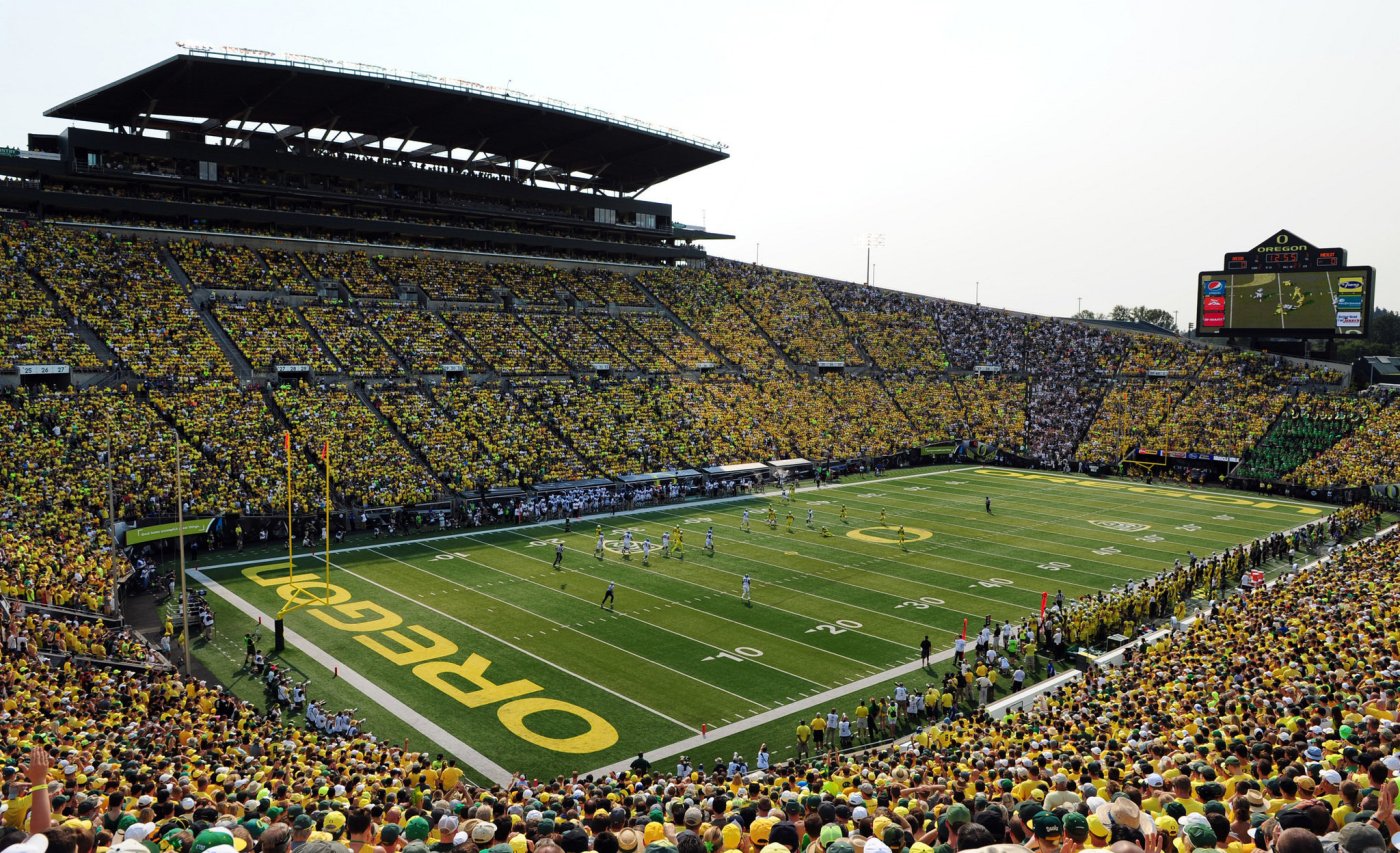The Hotline mailbag publishes weekly. Send questions to wilnerhotline@bayareanewsgroup.com and include ‘mailbag’ in the subject line. Or hit me on Twitter/X: @WilnerHotline
Please note: Some questions have been edited for clarity and brevity.
Oregon will play eight conference games in a row without an idle week. This is NFL-like and certainly not CFB-light. I believe the Ducks are the only Power Four team playing eight straight against Power Four opponents. Am I correct? — Jon Joseph
Indeed, you are correct.
The Ducks play eight consecutive Big Ten opponents from Week Five (Sept. 28) through Week 12 (Nov. 16).
A bevy of teams play power conference opponents for six consecutive weeks, and a handful (USC, Stanford, Louisville and UCF) play seven in a row. But Oregon is alone among the 68 teams in the Power Four. Nobody else has the octo-whammy.
How did this happen?
The 2024 season, which is based on the NCAA’s competition calendar, allows for each team to have two idle weeks. For most, one idle Saturday comes at the end of September or early October, after the start of conference play, and the second comes at the end of October or early November, before the stretch run.
But Oregon’s schedule is different. The first idle weekend comes after the non-conference games and before the Big Ten opener (at UCLA), and the second comes as late as possible: Week 13, just before the finale against Washington.
Important point: The Huskies are idle Week 13, as well, so that neither team has a competitive advantage. But UW’s first break comes Oct. 19, much later than Oregon’s respite. That means the Huskies open with three non-conference games and transition straight into four league games.
Could the Big Ten have done the same with Oregon, slotting a few league games into the schedule immediately after the non-conference dates and pushing the first break into early October?
Probably. But that might have caused an issue elsewhere — conference schedules are far more complicated than they seem, and the Ducks are hardly the only team with an arduous stretch.
That said, playing conference opponents eight weeks in a row presents a substantial challenge, especially given the travel situation:
— The stretch begins with the short trip to UCLA, followed by a home date with Michigan State (on a Friday) and the Ohio State showdown.
— From there, the Ducks head across the country on a short week to face Purdue in a classic trap game, then return home to play Illinois.
— The following week, they visit Michigan, then return home for Maryland.
— The stretch concludes with another long trip, to Wisconsin.
All in all, Oregon’s eight-week adventure features five opponents that were bowl-eligible last season, three trips across the Mississippi and two dates with Big Ten blue bloods.
It will be a supreme test of Oregon’s depth and resolve.
With all the hype, is Oregon overrated? (Asking for a friend.) — @mjhusky
Given the expectations accompanying a No. 3 position in the AP preseason poll and a Win Total of 10.5 (per FanDuel), there certainly is significant downside risk for the Ducks.
If your bar for them is 11-1, a spot in the Big Ten championship game and advancement to the CFP semifinals, then yes, hindsight might show they were overrated.
But as we see their roster and competition, the expectations appear accurate. They have an elite quarterback, Dillon Gabriel, who has proven himself at the Power Four level (with Oklahoma), plus a barrage of playmakers, stout lines of scrimmage and a first-rate secondary.
Will coach Dan Lanning manage the risk-reward calculation in the fourth quarter of big games?
Will they stay healthy at the positions with the least amount of depth?
And will they avoid playing a bad game — there’s always one, for everybody — at precisely the wrong time, against an opponent good enough to take advantage?
Every season is defined by two or three games, and those games are shaped by three or four plays.
The Ducks possess the necessary ingredients to land on the right side of the tipping-point plays. But with expectations in the stratosphere, reality will play out on the margins.
Do you think Cal and Stanford are having buyer’s remorse about jumping ship to the ACC? — @CelestialMosh
Our sense from discussions with Stanford and Cal officials and constituents over the past 12 months is that nobody wanted to join the ACC in the first place.
Both schools had hoped the Pac-12 would remain intact and expected the conference to sign a media rights deal right up until the point everything collapsed.
The ACC was viewed as the best option in a desperate situation, so I’m not sure the term buyer’s remorse even applies.
Florida State and Clemson filed their lawsuits long after the Bay Area schools accepted membership. But the Cardinal and Bears knew in advance that the Seminoles, in particular, were unhappy. (They certainly should have known.)
Do we think the key decision-makers are regretting the ACC move? Nope. They still see the ACC, for all its flaws, as a better place than a rebuilt Pac-12.
That sentiment could change in a few years. The situation is quite fluid.
If Washington State and Oregon State rebuild the Pac-12, who do you see as the top contenders besides all the Mountain West teams? — @ChuckShute
What few options exist are currently planted in the American Conference — maybe Memphis or UTSA, perhaps Tulane or Rice.
None of the Sun Belt schools work logistically or financially; nor do members of Conference USA; and the MAC isn’t breaking up. (The MAC is underrated for its stability. Those schools are fully aligned.)
The top teams in the American would give a rebuilt Pac-12 greater geographic sweep and, in some cases, boost the competitive product. But are any of them willing to leave the AAC, which has a media rights deal with ESPN into the 2030s?
We’re skeptical.
A merger, or reverse merger, with the Pac-12 and the Mountain West is the most practical solution. Whether it involves all or some MW schools is the great unknown.
Do you still plan to write about the recent conference payouts, including the massive amounts distributed by the Big Ten and SEC. Those factors, and how they will affect the power conferences, seem to be the most important subject (and concern) within college athletics. — Jim Varnell
We still plan to cover the conference revenues and campus distributions, just as we always have.
And yes, the marked discrepancy in cash flow between the SEC and Big Ten and the ACC and Big 12 will continue to define the competitive landscape.
Especially when two monumental changes take hold:
— The implementation of a revenue-sharing plan in which each school can distribute up to $22 million (approximately) to athletes each year.
— The start of the next College Football Playoff contract cycle in 2026, which allocates millions more to the SEC and Big Ten schools than their ACC and Big 12 counterparts.
By the late 2020s, the disparity in total campus distributions, which includes media rights revenue, CFP shares and NCAA Tournament units, will approach $50 million per school in some cases.
Meanwhile, the cost of business will continue to soar.
Perhaps in three years — maybe it’s five, or 10 — the pressure on the system will become so great that a rupture occurs at the power conference level.
Which brings us to …
When does it all end? If they go to some 32-team super league, it destroys college athletics as we know it. — RealWebTraveler
Fans of the teams participating in the super league, if it comes to fruition, probably won’t bemoan the situation. Everyone else will undoubtedly have some degree of regret, frustration, sadness or, perhaps, relief.
Relief, because the super league will create level playing fields.
The schools capable of competing with Georgia and Ohio State will have the platform to do just that, while the schools that don’t have the proper resources — the dozens and dozens of schools that don’t — will instead compete on a landscape with similar programs.
Although we aren’t convinced the process will play out in its purest form, a true super league would have as few as 24 and as many as 48 schools. Plenty of teams currently in the Power Four would miss the cut and compete on the same level as the current Group of Five teams.
And that’s where they would belong, frankly.
Related Articles
Recruiting roundup: Assessing the top 2025 targets for the current and former Pac-12 schools
Picks of the Week: Colorado handles NDSU, USC edges LSU, ASU struggles
Washington enters Big Ten as big financial challenges face Pat Chun
On CFB media: Deion Sanders’ thin skin, SEC on ABC, ESPN’s big ratings
Arizona football: Expectations soar as Brent Brennan era begins
The bifurcated system will result in better competition on each tier.
I read about the idea of Olympic sports returning to a regional conference. Would this not be grounds for a Title IX lawsuit? Volleyball players, for example, would lose national TV exposure and branding compared to football players. — @Brian_Wood45
It’s a fair point, given that seemingly every rule in the NCAA manual gets challenged in court — and the plaintiffs always win.
Certainly, a regionalized system for Olympic sports would be viewed in some corners as inequitable, especially if men’s basketball is not part of the regionalization.
The longstanding debate in the Title IX space is whether the 1972 federal law requires equal opportunity or equal resources.
We’ll know sooner than later thanks to lawsuits against the NCAA resulting from the House settlement that created the revenue-sharing model set to be implemented next year.
The House plaintiffs don’t believe Title IX should apply because the revenue-sharing amount is linked to the athletes’ name, image and likeness (NIL) — a market-based valuation unaffected by federal education law.
Exactly how the courts define Title IX in a revenue-sharing era will provide insight into the impact it might have in a world with regionalized Olympic sports.
That world could come sooner than later. Our hunch is the Olympic sports stakeholders will quickly realize the insanity of having soccer and softball teams schlep across the country for conference competition.
*** Send suggestions, comments and tips (confidentiality guaranteed) to wilnerhotline@bayareanewsgroup.com or call 408-920-5716
*** Follow me on Twitter/X: @WilnerHotline












